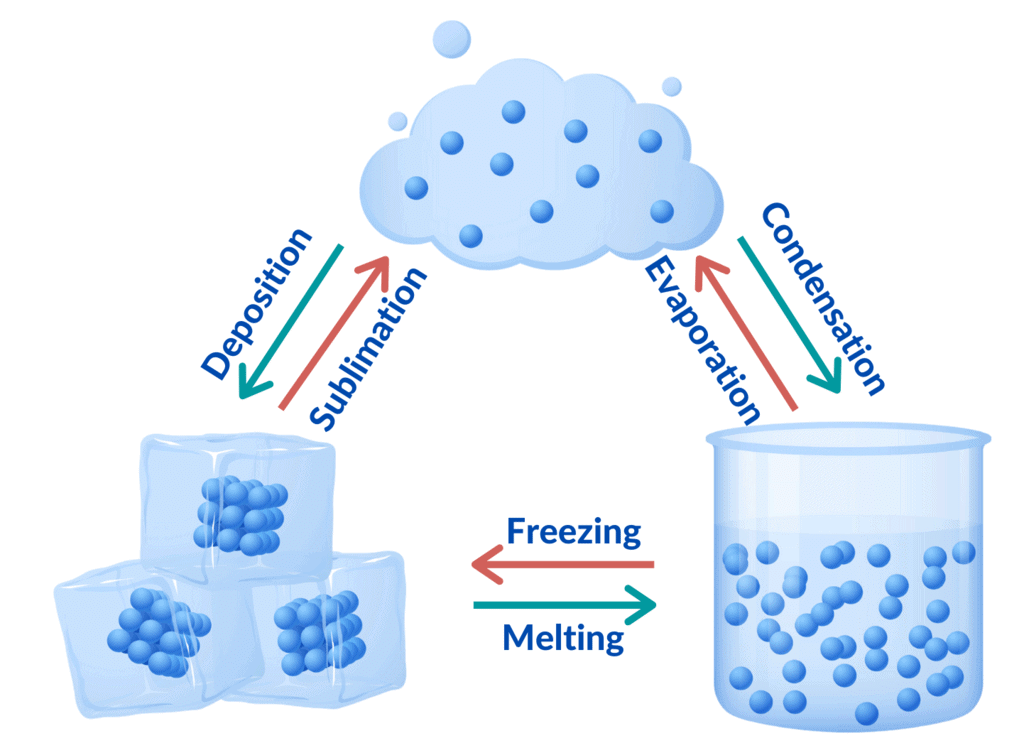Changes Around us Class 6 Notes Science
Every day, we see different types of changes around us, like day turning into night, the season changing from winter to summer, melting of ice to water, cooking of food, and so on. Changes take place around us all the time. However, all changes are the same. We get back the original substance in some, and can't get them back in others.
Can all Changes always be Reversed?
Any difference in the size or shape of an object is referred to as a change.
Changes are either reversible or irreversible.
A reversible change is a change that can be undone or reversed.
- Melting is an example of a reversible change.
- Boiling, evaporation and condensation are all examples of reversible changes.
- For example, if you could capture all the steam that is made when a kettle boils, you could turn it back into water by cooling it.
- Some other examples of reversible changes are the melting of ice, folding paper and blowing a balloon.
- A blacksmith changes a piece of iron into different tools. For that, a piece of iron is heated to red hot. This also softens it. It is then beaten into the desired shape. It is a reversible change.
An irreversible change is a permanent change that cannot be undone. In an irreversible change, new substances are formed.
- The cake batter is made from eggs, flour, sugar and butter. Once the cake has been baked, you cannot get the ingredients back.
- Heating a substance can cause an irreversible change.
- Cooking is another example. We cannot get back the substances that we originally started with
- Mixing substances can also cause an irreversible change.
 Fig: CookingFor example, when vinegar is mixed with the bicarbonate of soda, you can observe the release of carbon dioxide gas in the form of bubbles. Again, here, we cannot get back the original substances.
Fig: CookingFor example, when vinegar is mixed with the bicarbonate of soda, you can observe the release of carbon dioxide gas in the form of bubbles. Again, here, we cannot get back the original substances.
- Some other examples of irreversible changes are the digestion of food and the heating of limestone.
- The burning of wood is also an irreversible change. Once wood is burned, it changes to ash, and we cannot get back the wood again.
Finally, our growth itself, as you can see, is an irreversible change.
Could there be Other Ways to Change?
Expansion and Contraction
When the temperature increases, the particle of a substance expands or becomes loose. When this happens, the material is said to undergo expansion.
When the temperature decreases, the particles of the substance contract or become tight. When this happens, the material is said to undergo contraction.
The amount of expansion or contraction varies in solids, liquids and gases.
There are physical changes that take place when a substance or material moves from one state of matter to another.
Water is a classic example as it can exist as either solid, liquid or gas.
Water at very low temperatures exists as a solid known as ice. On applying heat or increasing the temperature, the ice ‘melts’ to form water. The physical change when a solid changes to a liquid is called melting.
If we keep increasing the temperature, the water now starts to boil until it fully becomes water vapour. The physical change when a liquid changes to gas is called evaporation.
To get back the water from water vapour, it is possible by condensation – a physical change where the gas changes to a liquid. This is possible by lowering the temperature.
 Changes in States of Matter
Changes in States of Matter
Anomalous Expansion of Water
Water on cooling contracts up to 4∘C. On further cooling, up to 0∘C, water expands rather than contracting with a decrease in temperature. This means that as the temperature decreases from 4∘C to 0∘C, water expands. This behaviour is called the anomalous expansion of water.
Burning
Burning is an irreversible change where a substance burns to produce new material. These new materials are ash and some gases.
For example. paper is burnt to produce ash, which is different from paper in terms of appearance and properties.
Separation
The separation of the components of a mixture or an impure substance is carried out for the following purposes:
- To remove the unuseful or harmful component.
- To obtain the useful component.
- To remove impurities for getting a pure sample.
|
53 docs|6 tests
|
FAQs on Changes Around us Class 6 Notes Science
| 1. Can all changes always be reversed? |  |
| 2. What are some other ways to change? |  |
| 3. How do changes around us affect our daily lives? |  |
| 4. Can changes be both positive and negative? |  |
| 5. How can we adapt to changes around us? |  |

















